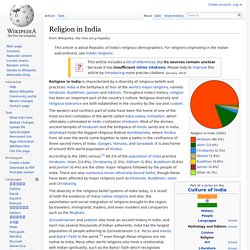

Religion Statistics - Top 10 Organized Religions. Religion in India. This article is about Republic of India's religious demographics.

For religions originating in the Indian subcontinent, see Indian religions. Religion in India (2001) Other (0.7%) Religion in India is characterized by a diversity of religious beliefs and practices. India is the birthplace of four of the world's major religions; namely Hinduism, Buddhism, Jainism and Sikhism. The western and northern part of India have been the home of one of the most ancient civilization of the world called Indus valley civilization, which ultimately culminated to Vedic civilization Hinduism. According to the 2001 census,[1] 80.5% of the population of India practice Hinduism. The diversity in the religious belief systems of India today, is a result of both the existence of many native religions and also, the assimilation and social integration of religions brought to the region by travelers, immigrants, traders, and even invaders and conquerors such as the Mughals.
History[edit] Pre-historic religion[edit] Indian religions. Ganesha, a deity common to Hindus, Jains, and Buddhists.

Primarily a widely-worshipped Hindu deity. Indian religions are the religions that originated in the Indian subcontinent; namely Hinduism, Jainism, Buddhism and Sikhism. [web 1][note 1] These religions are also classified as Eastern religions. Although Indian religions are connected through the history of India, they constitute a wide range of religious communities, and are not confined to the Indian subcontinent. [web 1] Evidence attesting to prehistoric religion in the Indian subcontinent derives from scattered Mesolithic rock paintings. Where the two oceans meet: an attempt at Hindu-Muslim rapprochement in the thought of Dara Shikuh. In Search of..... - TV.com www.tv.com/shows/in-search-of Narrarated by Leonard Nimoy, In search of was a 30 minute syndicated show that covered a wide range of paranormal topics.

It pioneered a lot of the methodology that ... Search Engine - Download.com download.cnet.com/s/search-engine search engine free download - GSA Search Engine Ranker, Nomao - The personalized search engine, Zoom Search Engine, and many more programs Google Search - Download.com download.cnet.com/s/google-search google search free download - Google Search, Google Toolbar for Internet Explorer, Google Search, and many more programs Star Search - Episode Guide - TV.com www.tv.com/shows/star-search-2003/episodes. South Asian Religions — Center for South Asian Studies, U.Va. Guide to South Asian Religion. Sacred Books of the East Index.
Sacred-texts home Hinduism Taoism Confucianism Buddhism Jainism Islam ZoroastrianismBuy CD-ROM Buy books: Sacred Books of the East Table of ContentsIndex of TranslatorsTransliteration TablesAvailable reprints The Sacred Books of the East (SBE) series, comprising fifty volumes, was issued by the Oxford University Press between 1879 and 1910.

It has translations of key sacred texts of Hinduism, Buddhism, Taoism, Confucianism, Zoroastrianism, Jainism, and Islam. The series was edited by the famous linguist and scholar of comparative religion, Max Müller. He wrote three of the volumes, and collaborated on three others. This series was the one of the inspirations for the sacred-texts website. NEW: The SBE is complete. Axial Age. Axial Age or Axial Period (Ger.

Achsenzeit, "axis time") is a term coined by German philosopher Karl Jaspers to describe the period from 800 to 200 BC, during which, according to Jaspers, similar revolutionary thinking appeared in Persia, India, China and the Occident. The period is also sometimes referred to as the Axis Age.[1] Jaspers, in his Vom Ursprung und Ziel der Geschichte (The Origin and Goal of History), identified a number of key Axial Age thinkers as having had a profound influence on future philosophies and religions, and identified characteristics common to each area from which those thinkers emerged.
Jaspers saw in these developments in religion and philosophy a striking parallel without any obvious direct transmission of ideas from one region to the other, having found no recorded proof of any extensive intercommunication between Ancient Greece, the Middle East, India, and China. A pivotal age[edit] Thinkers and movements[edit]